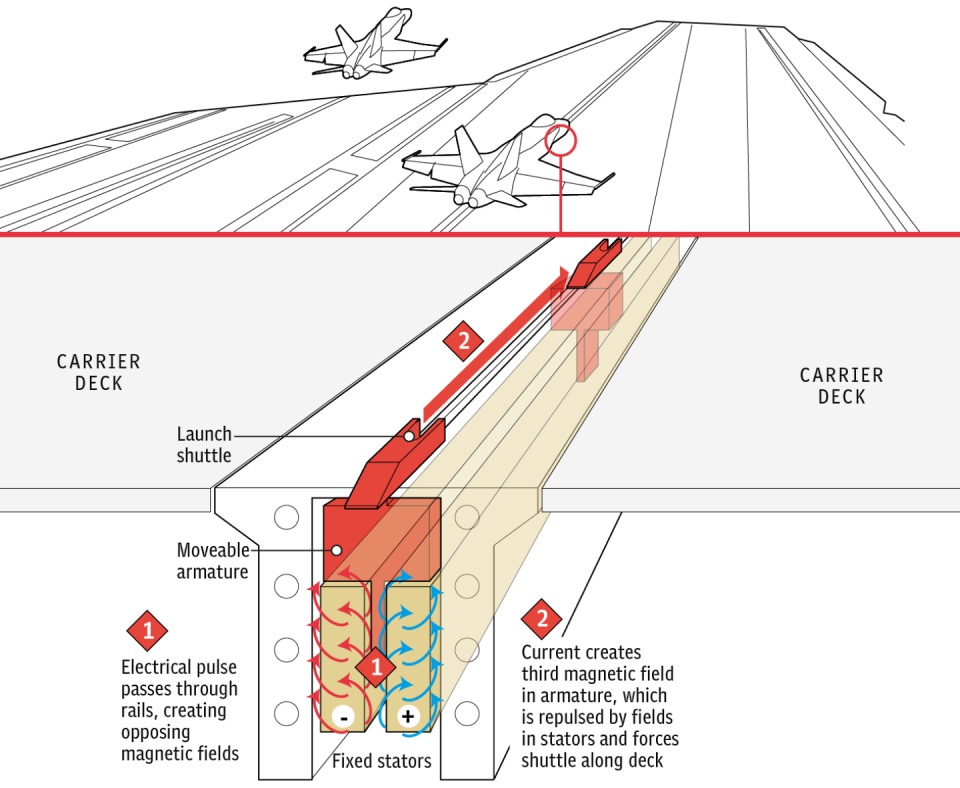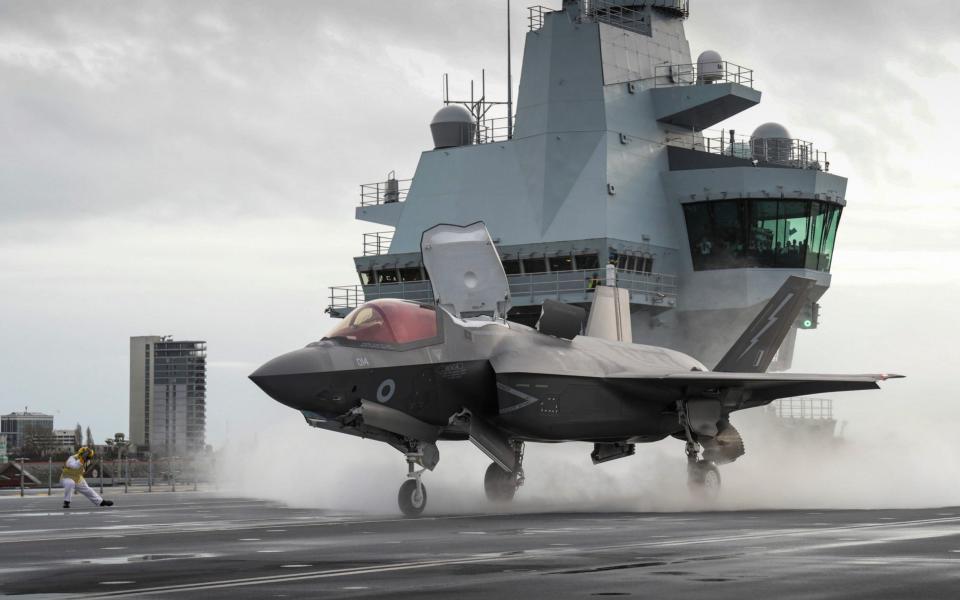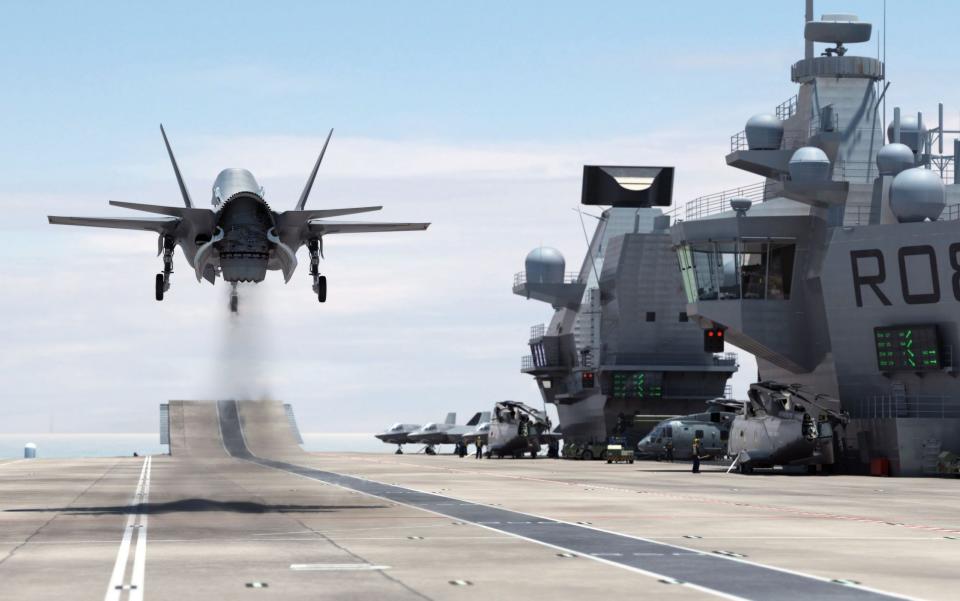Royal Navy eyes 'catapult system' to launch drones and jets from aircraft carriers

The Royal Navy is seeking a catapult system to launch drones and jets from aircraft carriers as a possible “Plan B” for the F-35.
The MoD has asked industry for ideas about future “aircraft launch and recovery systems” that could be fitted to ships in the next five years.
The document issued by the MoD says it “wishes to assess the availability of electromagnetic catapult, and arrestor wire systems for the launch and recovery of air vehicles”.

Potential solutions should be “sufficiently technically mature to be fitted to a suitable ship from 2023”.
The system must be capable of launching an aircraft of almost 25 tonnes, with arrestor gear able to handle just over 21 tonnes - the discharge of fuel and weapons reducing the weight of returning aircraft.
These weights are typical of modern-day crewed fighter aircraft, but might also indicate future heavy-lift drones providing combat, refuelling, airborne radar or logistic services are being considered.
Aircraft are catapulted from ships using either high-pressure steam from the ship’s reactors or, in modern systems, electromagnetic power. The towbar on the jet’s front wheels is attached to a block that runs in a channel along the flight deck. To land, the pilot has to snag steel cables stretched across the ship with a hook at the tail of the aircraft.

George Allison, of the UK Defence Journal, said the request from the MoD “shouldn’t be taken as an indication that the Royal Navy are abandoning the short take-off and vertical landing F-35B model and returning to catapult launched fighters”.
More likely, the system would be used for “larger uncrewed aircraft as the armed forces begin to rely on them more, in place of crewed platforms,” he said.
It is anticipated that the forthcoming Integrated Review (IR) will reduce the total number of F-35 jets from 138 to the 48 for which £9 billion has already been committed. No announcement about future launch systems for aircraft carriers is expected in the IR.
Tim Ripley of Jane’s Defence said the idea of using an electromagnetic catapult system and arrestor gear - known as ‘cats and traps’ in defence circles - showed the MoD was experimenting in a bid to avoid mounting defence procurement costs.
The F-35 programme has produced affordable jets, he said, but the wider systems required to support the highly technical aircraft meant the project overall was hugely expensive.
“They seem to have been able to make it to price, but they can’t operate it to price, [the MoD] needs to have a Plan B,” he told the Daily Telegraph.

His concerns echo recent comments from the US Chief of the Air Staff.
General Charles Q. Brown hinted that supporting F-35 operations was so expensive they should be used less as a multi-mission fighter as originally envisaged, and more for special missions only.
“I want to moderate how much we’re using those aircraft,” he said.
“You don’t drive your Ferrari to work every day, you only drive it on Sundays.
“This is our ‘high end’ [fighter], we want to make sure we don’t use it all for the low-end fight … We don’t want to burn up capability now and wish we had it later.”
Mr Ripley says as the Royal Navy’s new Queen Elizabeth-Class aircraft carriers are expected to remain in service for around 50 years they won’t always fly the F 35B.
The MoD's future combat air system - called Tempest and expected to be a mix of crewed planes and drones - could well be operated by cats and traps. Tempest is due in service from the mid-2030s.
With engineering spaces below the flight deck Britain's new carriers have been built to take electromagnetic catapult systems in the future if need be.
HMS Prince of Wales had originally been designed with the US Navy’s EMALS system (Electromagnetic Aircraft Launch System) in mind.

However, when the MoD decided to buy the vertical take-off variant of the F-35, the plans were stopped.
Electromagnetic catapults allow for a smoother acceleration of the aircraft compared to steam systems, thereby reducing stress on airframes.
The Royal Navy has embarked on a drive for innovation, with the Future Maritime Aviation Force, which may include this system, being a key element.
Gareth Corfield, a defence specialist, said: "The weights this proposed catapult is supposed to handle are well below the F-35C's (the carrier variant) maximum takeoff weight of 32 tonnes. But it could be an early look at how the Tempest optionally manned aircraft could be used by the Royal Navy.
“Timing is key and the 2023 installation date might fall towards the end of HMS Queen Elizabeth's first major refit after her South China Sea deployment later this year."

A Royal Navy Spokesperson said the service was "committed to ensuring it is ready to confront future wars, and is exploring the use of novel and innovative technologies including uncrewed air systems.
“This tender is purely an information gathering exercise to gauge existing technology and it is not an indication of intent of further procurement activity.
“The Armed Forces regularly conduct fact finding exercises with industry partners to understand the latest technological developments and how they can improve existing equipment to meet future threats.”
Watch: MHP drone pilot explains how drone was used during chase

